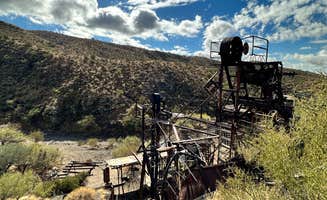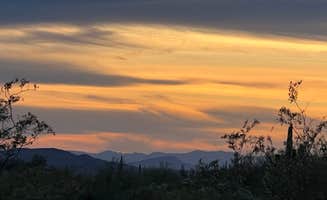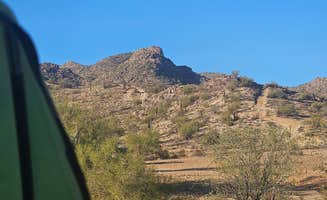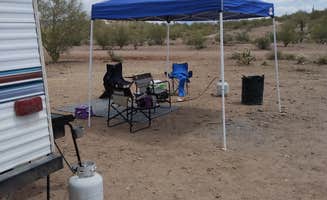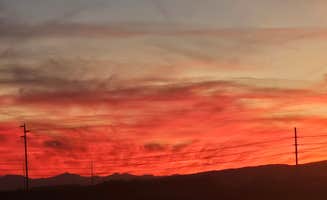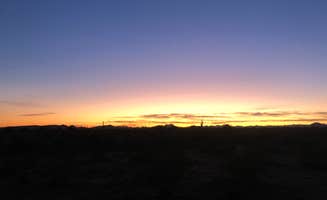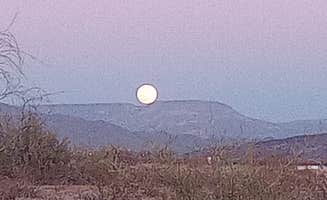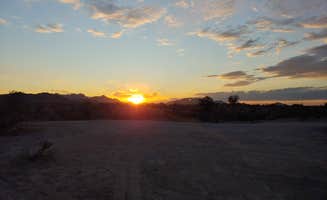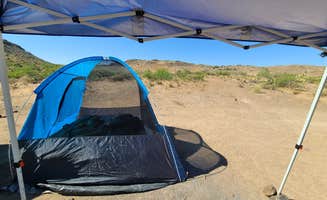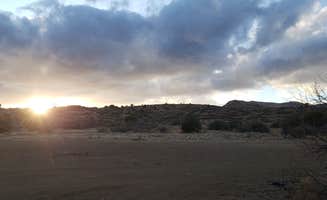Dispersed camping near Morristown, Arizona concentrates around the Sonoran Desert lowlands, averaging 2,100 feet in elevation with winter daytime temperatures typically ranging from 65-75°F. The landscape features volcanic rock formations alongside desert vegetation dominated by creosote bush, palo verde, and saguaro cacti. Most primitive sites have hard-packed gravel or sandy soil bases suitable for camp setups.
What to do
Explore OHV trails: Several staging areas around Morristown serve as starting points for off-road adventures. At Boulders OHV Area, "There are several fenced in and cleared dirt areas to park and pull through trucks, a camper, tent and car, etc. any vehicle can make it to the staging area, road is easy to travel," notes Miriam D P. The network includes routes suitable for beginner to intermediate riders.
Wildlife viewing: Early mornings offer the best opportunities to spot desert wildlife. "Fantastic views and quiet atmosphere, so far. Been here two nights and plan to stay for at least another week. Wild burros wander through occasionally, and coyotes make their presence known as well," reports William M. from Old Airstrip Camping & Staging Area.
Visit abandoned mines: The area contains numerous historic mining sites accessible via primitive roads. Near Sophie's Flat Trailhead, "Nice spot, pretty clean. Pretty easy to get to. There is a dirt road leading up to it. I think most size rigs could make it," according to Robert F. From this access point, hikers can reach several mining ruins within a few miles.
What campers like
Desert solitude: Many campers appreciate the spaciousness and quiet atmosphere. At Vulture Peak Road North State Trust Land, despite some drawbacks, campers find isolation. "Access road is fresh gravel so better than 2024. Large open flat area in middle close to a livestock water and corral," notes Greg L.
Stargazing opportunities: Clear desert skies create exceptional night viewing conditions. "Verizon had about 2 bars of service for texting and calling. Some internet browsing," reports Zack E. about Ghost Town Road BLM Camping, adding that the area is "Clean. Quiet. Easy roads."
Winter temperatures: Mild winter conditions make this region popular for seasonal camping. "So thankful for this desert and the solitude it brought. The further off carefree you get, the more solitude you'll find. It's been pretty windy (25-30mph gusts) which causes a lot of dust but it's gorgeous and warm during the day, even in January," writes Conner F.
What you should know
Permit requirements: Some sites require state land permits. "State land trust, good spot for a few nights. Gunshots in the distance, but no incidents/casualties lol. Pulled my 31ft TT back into a spot for a week. Close 10 min drive to stores like WinCo and Safeway and gas stations," explains Brent T. from State Land Trust/Inspiration Point.
Road conditions: Access roads vary significantly in quality. "Rough sloped area at crest by cell tower. There is another better quality road slightly south of this rough upper area that I include in this camping area," describes Greg L. Most sites require driving on at least some graded gravel roads.
Wind exposure: Many sites lack natural windbreaks. "It's not bad most days. The wind gets pretty strong out here and there are a lot of side by sides that run very late into the night in the weekends, usually. The temps are a little cooler because of the proximity to Lake Pleasant," notes Eric S.
Tips for camping with families
Choose sites away from OHV staging areas: For quieter family camping, select locations removed from popular riding zones. "If you dont mind occasional off road vehicles driving through during the day, its a good spot with plenty of room," advises Daniel B. about Boulders OHV Area.
Bring plenty of water: No potable water exists at any primitive sites around Morristown. "This area has very good cell phone service. Really good cell phone service (Verizon - I got 3-4 bars of 4G, which got me 75+ mb/s download speed)," mentions Russell C., which helps with emergency communication despite the lack of facilities.
Watch for natural hazards: Desert camping requires awareness of cactus spines and wildlife. "We have a 4WD truck, so we were able to get past most of the RVs and toy haulers, but they all seemed like family friendly people! The burros are no joke! You can hear and see them all around you," cautions Elisabeth Q.
Tips from RVers
Water and dumping services: RVers need to plan for water access and waste disposal. "If you need to dump and/or get fresh water Wickenburg is just miles up the road and the Fast Mart Chevron station has two stations for this, plus propane. We paid $15 to dump and the potable water fill up was included," shares David M. from North Castle Hot Springs Road Camp.
Finding level sites: Some areas offer better natural leveling than others. "Nice and levelled. We liked it there. Nobody else on Friday night, plenty of space. The typical rumble strip dirt road to this point but easily doable," reports Ralph S.
Stay length considerations: While most sites maintain the standard 14-day limit, enforcement varies. "That's right, this is AZ, State Trust land, AKA: FREE camping and parking land—72,000 acres of open dispersed, rough, rugged, off-the-grid life. I've parked here in my converted Skoolie of 36 feet for two years," explains The Wanderer about Maddock Road Dispersed camping.


